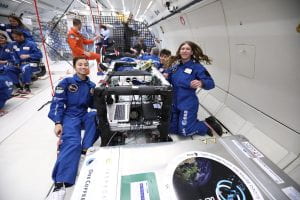
Walking in the air: University of Brighton researchers touch down after testing ground-breaking devices in zero gravity
Researchers have spent last week suspended in space-like conditions as they put two experiments through their paces during weightless parabolic flights.
The two projects tested, GELL-P and DEPLOY!, both have potential applications for space exploration and on earth.
Rachel Forss from the School of Sport and Health Sciences and the Centre for Regenerative Medicines and Devices, who led the GELL-P project, said of the flight: “It was amazing! A bit like swimming underwater but with less resistance and control. A unique experience; the zero g is quite pleasant, but the 1.8g on either side is what makes it tiring.”
The GELL-P project team analysed a pioneering lower limb testing kit to learn more about wound healing in space which, in turn, will lead to improved diagnosis. The project will help future space missions predict the effect of hyper gravity conditions on lower limbs such as those experienced by astronauts, fighter pilots and racing car drivers as well as in everyday healthcare settings with the assessments for patients. The team are the first UK podiatrists to conduct experiments in weightless conditions.
Rachel said: “For our team, its vital to test the vascular system under these conditions, as no amount of ground based activities will enable us to replicate 0g and 1.8g conditions.
“As space tourism expands we need to understand what happens to the foot and lower leg blood perfusion to enable appropriate advice and preventative measures to be identifies to prevent harm to the potential flyers.”

Erin, far right in photo
The DEPLOY! Project team, including University of Brighton student Erin Saltmarsh who is studying for an Aeronautical Engineering MEng, were focused on testing an innovative, flexible heat transportation pulsating heat pipe (PHP) which has potential to be used for space vehicles such as satellites. The device is particularly suitable for space flight because of its lightweight nature and small size as well as its unique ability to be deployed in three different positions and be folded back against the space vehicle, much like the wing mirrors on a car, minimising the risk of damage from space debris.
Erin said of the experience: “The flights were amazing. We couldn’t have hoped for a more successful project and have collected some good data. We are now processing the data from the flights.”
The DEPLOY! project is a collaboration between the University of Brighton, University of Pisa and the University of Parma with funding provided by the ESA Academy Experiments programme, which provides funding and support for university students to develop their research in the fields of space science and technology, and the UK Space Agency.
Student Erin joined the team following a lecture about the project by School of Architecture, Technology and Engineering Principal Lecturer and mentor for the first European Low Gravity Research Association mentoring scheme (ELGRA) Dr Nicolas Miché. Dr Miché then introduced her to team leader Alessandro Billi, an aerospace engineer at the University of Pisa.
Parabolic flights involve a flight pattern whereby the plane goes into freefall producing zero gravity conditions. During each of three flights researchers went from 1.8 times the force of gravity to weightlessness 30 times per flight as the plane climbed to an altitude of 7,500m before beginning its dive. Each time the flight went into freefall researchers had around 20 seconds of weightlessness to conduct their experiments.

Images: copyright Novespace